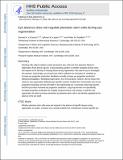Eye Absence Does Not Regulate Planarian Stem Cells during Eye Regeneration
Author(s)
LoCascio, Samuel Alexander; Reddien, Peter; Lapan, Sylvain W.
Downloadnihms849826.pdf (2.115Mb)
PUBLISHER_CC
Publisher with Creative Commons License
Creative Commons Attribution
Terms of use
Metadata
Show full item recordAbstract
Dividing cells called neoblasts contain pluripotent stem cells and drive planarian flatworm regeneration from diverse injuries. A long-standing question is whether neoblasts directly sense and respond to the identity of missing tissues during regeneration. We used the eye to investigate this question. Surprisingly, eye removal was neither sufficient nor necessary for neoblasts to increase eye progenitor production. Neoblasts normally increase eye progenitor production following decapitation, facilitating regeneration. Eye removal alone, however, did not induce this response. Eye regeneration following eye-specific resection resulted from homeostatic rates of eye progenitor production and less cell death in the regenerating eye. Conversely, large head injuries that left eyes intact increased eye progenitor production. Large injuries also non-specifically increased progenitor production for multiple uninjured tissues. We propose a model for eye regeneration in which eye tissue production by planarian stem cells is not directly regulated by the absence of the eye itself. Keywords:
planarian; regeneration; stem cell; eye; tissue turnover; target blind; progenitor; neoblast
Date issued
2017-02Department
Massachusetts Institute of Technology. Department of Biology; Massachusetts Institute of Technology. Department of Brain and Cognitive SciencesJournal
Developmental Cell
Publisher
Elsevier
Citation
LoCascio, Samuel A. et al. “Eye Absence Does Not Regulate Planarian Stem Cells During Eye Regeneration.” Developmental Cell 40, 4 (February 2017): 381–391 © 2017 Elsevier Inc
Version: Author's final manuscript
ISSN
1534-5807
1878-1551